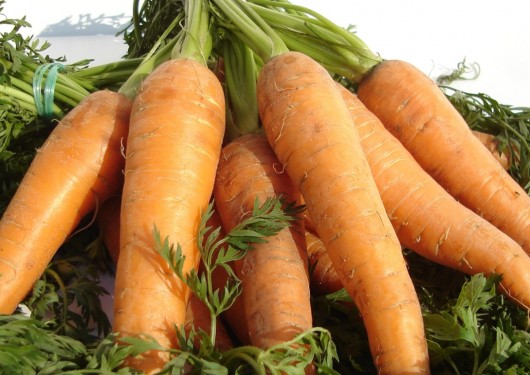Carrots And Carrot Juice
Carrots: What You Didn’t Know
Carrots are some of nature’s most interesting vegetables, shaped like thin orange tapered cones. These roots grow in the ground, with only a set of grassy leaves to distinguish them. To harvest carrots, simply grab the plant at its base and pull.
The carrot was initially a wild plant in Europe and the Middle East with an abnormally long and thick taproot, though still puny by today’s standards for carrots. The leaves and seeds were used for medicinal purposes throughout the Middle Ages, and little attention was paid to the root. It wasn’t until the 17th century that Dutch farmers bred the plant to improve the root’s size, taste and color. Interestingly, the carrot’s distinctive orange color came about because Dutch farmers, who popularized the carrot as a food, associated the color orange with the struggle for Dutch independence. Carrots actually come in colors ranging from white to yellow to deep purplish red.
Carrot Juice
It is very rare to find carrot juice outside of the health food aisle in the average grocery store, simply because it’s considered a vegetable rather than a fruit. As a result, carrot juice is typically mixed with other vegetable juices such as V8 rather than being sold on its own. Carrot juice is also rather expensive to juice for a variety of reasons, including low juice content per carrot. People who drink it report a taste similar to apple juice, with a slight tang as if some orange were poured in.
Interesting Fact – Carrot Juice, Every Aviator’s Best Friend
Carrot juice also helped the British to win World War II, as the Royal Air Force spread a rumor that its pilots drank lots of carrot juice which allowed them to see in the dark. This rumor was meant to cover up the truth – that the British army had developed advances in radar technology that allowed British fighters to engage their German counterparts under cover of night.
Health Benefits of Carrot Juice
There was some truth to the rumor spread by the Brits to throw the Germans off their scent. Carrot juice is exceptionally good for eye health, as it contains a lot of beta-carotene. The juice also contains loads of useful minerals such as copper, iron, phosphorus, potassium, calcium and magnesium. To round out the health benefits of carrot juice, drinkers can expect a jolt of all-natural energy after a glass due to all the B-complex vitamins in the juice.
Be careful not to drink too much though! Over three cups of pure carrot juice in a 24 hour period can cause carotenoderma, meaning that your skin turns orange! It’s harmless, but you might get made fun of by friends for your tan gone awry.
How to Juice Carrots
Carrots are quite difficult to juice for a variety of reasons. First, the yield is quite low, with a pound of carrots yielding only about a cup of liquid juice. Because carrots are very fibrous, pulpy vegetables, it is extremely difficult to separate the juice in a carrot from its physical substance. However, if you’re determined to make juice from your carrots, blend the carrots really well first. Pour one cup of hot water in with the resulting pulp per pound of carrots blended. Wait about half an hour while the water draws the juice out of the carrot. Then strain out the juice from the pulp. Voila! Instant carrot juice. There are also other ways to make carrot juice, for instance with a juicer – just check the articles below.
More Articles On Carrots And Carrot Juice
Best Carrots For Carrot Juice And How To Choose Them
The best carrots for juicing are the Nantes types, which …Carrot Juice Side Effects – Can You Drink Too Much Of It?
While drinking carrot juice in moderation has significant health benefits, …Carrot Nutrition Facts
Carrot Nutrition Facts Betaine 0,1 mg Calcium 32 mg Calories …Health Benefits Of Carrot Juice
Carrots are one of the most popular vegetables in the …
